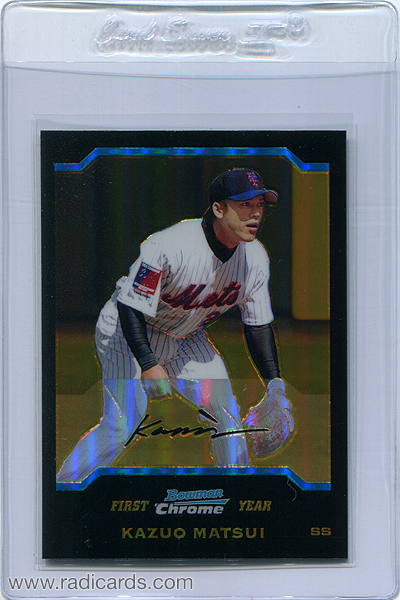
This guy was supposed to be a stud. But alas, this is another tragic but all too common story of a superstar hopeful turned average to sub-par in the professional arena. I can’t really hold that against a guy given the hyper competitive landscape of Major League Baseball. Kazuo was a rock star in his pre-2004 days so we have to at least give him that. His BA in the Japanese league between 1997 and 2003 was consistently above .300. For his entire American tenure, however, he would only touch a BA above .300 for a small portion of 2006 when he was traded to the Colorado Rockies. Kazuo ended his career in 2010 with the Houston Astros and would amass a lousy .141 BA that year for an American career AVG of .267. I’ve seen worse, much worse. Aside from 2010, his AVG was always in the mid to high .2s. I wouldn’t say he wasn’t talented but I wouldn’t put him in the elusive superstar category. Nonetheless, he did receive a decent salary for his total career and enjoyed a brief but mild amount of collectibility in 2004.
Shown is the Gold Refractor parallel of Kazuo Matsui’s 2004 Bowman Chrome card. This card once and for a very brief moment garnered some attention. Kazuo was even hot enough to grace the cover of Beckett Magazine. I can remember the cover; I can clearly remember the year. Between the death of Ronald Reagan, the airing of the final episode of Friends, the Montreal Expos announcing their move to Washington DC, and the Boston Red Sox winning their first World Series since 1918 was this kid from Japan coming to America to play for the New York Mets of the National League. 2004 was a different time.
Like many of us, I didn’t know much about Kazuo Matsui when he first appeared on the scene. Initially, I thought he may be related to Hideki Matsui but that would be about as accurate as assuming that skateboarding legend, Jamie Thomas is related in some way to baseball HOFer, Frank Thomas. Common last names are no more than just that… common last names.
I bought this 2004 Bowman Chrome Gold Refractor because I wanted at least one of his best 2004 cards that didn’t possess a relic or an autograph. There’s a funny story behind how I got this card. This card was listed online for an asking price of $39.99 for what seemed like forever. Okay, not forever obviously, but for several months. Anyway, there was a Best Offer option tied to the listing. I thought, what the hell, and placed a laughably low offer or $7, and it took! This leads me to believe the seller was hoping to get whatever he or she could by using the reflective high tag strategy. This is something that’s difficult to notice as a potential buyer and a low-ball offer has potential to backfire and offend the seller, which is something we want to avoid. It’s one of the very few times I’ve been successful at assuming an ultra low offer would have any chance of survival. Often times, high price tags on marginal items of varying significance equate to bloated zeal and an imperfect understanding of actual market value. I.e., some sellers think we’re idiots and try to rip us off. Or, they just want to show off their collection and have no interest in selling. Shameful, disgraceful, deplorable, egregious, [insert other adjectives here]. It’s all stupid.
I’m glad to have this card in the archive even though it’s only worth $7. I like it and it fits in well with my semi-star to star rookie card collection, which is small. I’m picky with what I buy. It has to mean something. This card means I spent $7. I kid; it actually means I cherish memories from 2004 and in a lot of ways, baseball cards are memories.
What’s one event you remember from 2004?

 Visit our store
Visit our store


